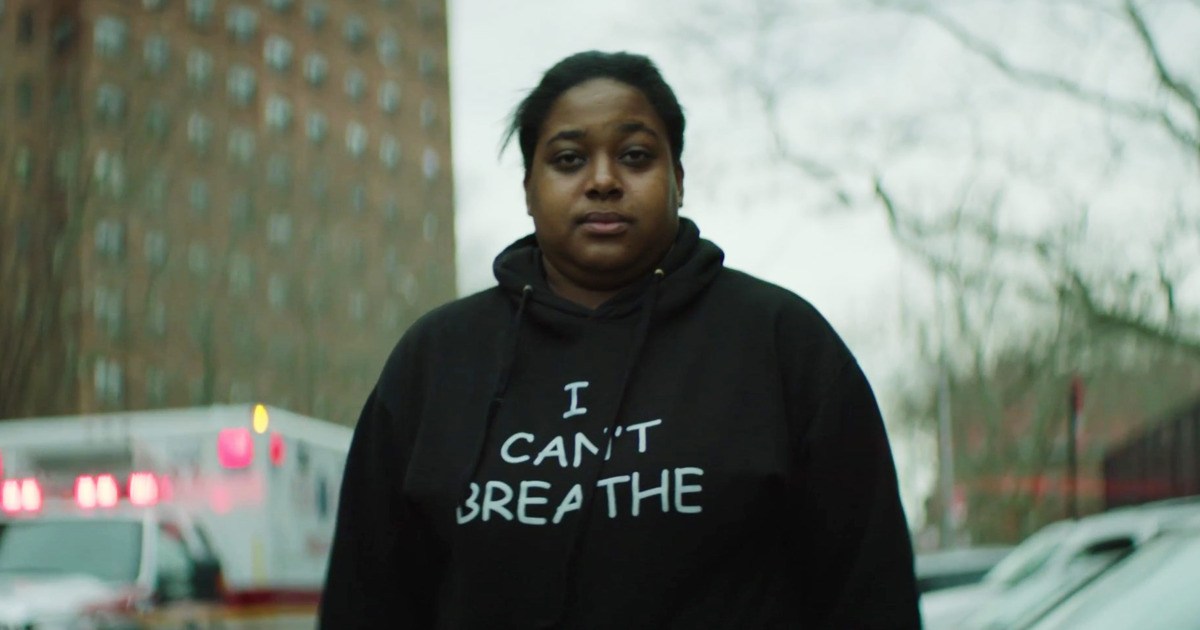“Doctors told her she had an enlarged heart when she suffered a heart attack four months ago after giving birth to her son, whom she named after her father, the “Daily News” reported. The pregnancy is said to have put too much stress on her heart.
The most recent heart attack was triggered by an asthma attack, relatives told the newspaper.”
(“Newsweek Magazine” , corroborated by the “International Business Times”)
Erica Garner… daughter, friend, activist, mother, woman… black woman…
Even though the Black Lives Matter Movement was founded by Alicia Garza, Patrisse Cullors, and Opal Tometi, Erica Garner became the name most closely associated with it… the face, if you will, of the Black Lives that Matter.
Erica appeared front and center on the national stage when she became the voice of her father, whose own voice had been silenced prematurely, and in the most inhumane of ways. His voice and his breath were snuffed out simultaneously, when Staten Island police attempted to detain him for selling loose cigarettes. He died while being restrained in a chokehold, and while struggling to utter the words,
“I can’t breathe.”
We often saw images of Erica clad in t-shirts that read those exact same words,
“I can’t breathe”.
And Erica challenged the police, and she challenged the judicial system. She challenged our elected officials and she challenged individual citizens. She challenged America’s collective and its philosophy. In short, she challenged the ENTIRE SYSTEM.
Senator Bernie Sanders described Ms. Garner as,
“…a leading proponent for criminal justice reform and for an end to police brutality…”
3 years after her father’s death, on December 24, 2017, Erica, too, became unable to breathe. After suffering what was described a heart attack and respiratory arrest, Erica was placed on life support… unable to breathe on her own. Days later, she was declared brain dead, and by December 30th, she had passed away.
Although many news outlets have reported on Ms. Garner’s death, most have attributed it simply to a “heart attack”. A few have mentioned that she suffered an asthma attack which precipitated the arrest.
Unfortunately, there has been little explanation as to the true underlying pathology that was responsible for her heart failure.
It is first important to note that “heart attack” is not a disease process. It is the consequence or sequelae of some underlying pathology.
All too often, when we hear “heart attack”, we presume that it results from atherosclerosis brought on by a lifetime diet of fatty foods and little exercise. It never occurs to us that there may well be other culprits.
In this case, it could have been asthma. However, some information has been shared as to what really went wrong.
In August 2017, Erica Garner gave birth to a baby boy. Sometime shortly after his birth, she suffered a “heart attack”, and was assessed for the root cause. At that time, she was diagnosed with “an enlarged heart”.
While I have not found a source to name her condition, it is very likely that she had Peripartum Cardiomyopathy. This is a rare condition in which, due to the many changes in pregnancy, a woman’s heart becomes enlarged and dilated. Due to this stretching of the muscle, the heart becomes somewhat flaccid and no longer contracts efficiently.
This means that blood and oxygen will be delivered to target organs at a much slower rate. Heart failure often results which leads to swelling in the lower extremities, as well as fluid build up in the lungs. Due to the pulmonary effect of the cardiomyopathy, a woman may experience shortness of breath, which can easily be confused with acute asthma. This is especially true in women who have a history of asthma, as was the case for Ms. Garner.
In the heart’s attempt to make up for the oxygen deficit that the organs are suffering, it tries to beat harder and faster, and eventually the fatigued muscle gives out entirely. Thus, the “heart attack”, or, more appropriately named, the “cardiac arrest”.
Some women will have peripartum cardiomyopathy and go on to live lives free of any symptoms. Others will see a decline in their pulmonary and cardiovascular health. With treatment in the forms of diuretics, ACE inhibitors and beta blockers, about 50% of women will go on to recover and have normal cardiovascular function without the need for further pharmaceutical intervention. 98% of women will recover. 4% will go on to require a cardiac transplant.
It is a known fact that African-American women are afflicted with this more often than their white counterparts. They are 2.9 times more likely than white women to have it and 7 times more likely than Latinas.
Unfortunately, peripartum cardiomyopathy is not the only place in which we see such health disparities. As it relates to prenatal complications as well as non-obstetric diseases, black women are far more likely to suffer most medical problems than are their white counterparts, even when issues like socioeconomic status are accounted for.
Why is that?
In other words,
“What are the factors that contributed to Erica Garner’s death besides her cardiac condition?”
An article in “Newsweek” began to examine some of the issues that help to create such disparities:
“The shameful secret is that even when controlling for age, socioeconomic status and education, the U.S. Centers for Disease Control and Prevention (CDC) reports that African-American women… face a nearly four times higher risk of death from pregnancy complications than white women. In parts of the U.S. with high concentrations of women of color who live in poverty, such as Mississippi, maternal death rates can surpass those of sub-Saharan Africa.
There are plenty of reasons why. One is simple: Women of color as a demographic have poorer health than white women and are therefore more likely to have high-risk pregnancies. While the incidences of hemorrhage, infection and pre-eclampsia—which have long been the leading causes of maternal death —are dropping, the proportion of maternal deaths from cardiovascular diseases and cardiomyopathy are climbing, now representing over one-quarter of pregnancy-related deaths, according to the CDC. And, says Dr. Michael Lu, the associate administrator for maternal and child health at the Health Resources and Services Administration, more and more women are entering pregnancy with chronic conditions, like hypertension, diabetes and obesity, that disproportionately affect poor and minority populations. For example, one study out of University of California, Davis, revealed that people with a lower socioeconomic status face a 50 percent greater risk of developing heart disease than other study participants.
Moreover, women with unplanned pregnancies are more likely to delay prenatal care, and the CDC estimates that women who receive no prenatal care are three to four times more likely to die of pregnancy-related complications than women who do, and women with high-risk pregnancies are five times more likely to die if they do not receive prenatal care. Again, there are clear demographic demarcations. “African-American and Latina women are about 2.5 times more likely to get delayed prenatal care than a white woman,” says Rachel Ward, a senior director of research at Amnesty International, who co-authored a report titled ‘ Deadly Delivery: The Maternal Health Care Crisis in the USA .’
Low-income women, women of color and immigrant women are more likely to be uninsured. Medicaid finances nearly half of all births in the U.S., but accessing quality prenatal care on Medicaid can be prohibitively difficult. ‘If you are eligible for Medicaid, there are still delays in bureaucracy and hurdles to getting access,’ says Ward. ‘Women who receive Medicaid have said that there are only so many doctors willing to accept them as patients. It takes time to find a doctor, and the longer you leave it in pregnancy, the less likely it is that a doctor will take you on.’
Logistical problems create challenges, as well. A 2013 survey from the Kaiser Family Foundation found that poor women are typically unable to get time off work, arrange transportation to clinics and find someone to watch their kids. Inflexible appointment hours and an absence of information in languages other than English create further obstacles.
Perhaps most distressing, racial and socio-economic factors also have a disproportionate effect on the quality of care mothers receive during childbirth. A report titled ‘Discrimination and Racial Disparities in Health’ from the Harvard School of Public Health found that bias, prejudice and stereotyping by health care providers contribute to delivering lower-quality care—affecting how mothers are treated during childbirth and the outcomes. ‘Assumptions are made about you when you walk through the door, based on how you walk, how you dress, whether you sound educated or not,’ says Chanel Porchia-Albert, founder and executive director of the Brooklyn-based Ancient Song Doula Services. ‘That affects the level of support you get.’
The journal “Blavity” broke all of this down on an anthropological level. Their assessment makes us come face to face with the most ugly truth that America just does not like to own. They posited the following,
“We must first understand that racism and anti-black violence have taken many forms and that they do not all manifest in quick spurts of deadly violence. Some, are quiet killers. They may take years to grow while being fed by a plethora of factors that have been intentionally and logistically put in place. Erica Garner’s death is not an unfamiliar or unlikely event. Black women are disproportionately affected by heart disease and are more likely to die from health problems like heart attack and stroke. The list of diseases that affect Black women at a higher incidence is quite extensive: Breast Cancer, Cervical Cancer, Fibroids, Diabetes, Premature Birth, etc. Healthcare providers tend to speak in accusatory and victim blaming tones when addressing these issues. Stating the primary culprit is the food and lack of exercise of the patients. These statements hold some truth. Exercise and diet are the best preventive medicine, but they are irresponsible when they do not consider the history of racism and barriers that black women face.
A history of disenfranchisement, redlining, and special hybridized forms of sexism and racism have left Black women neglected and susceptible to health issues. Redlining is the intentional segregation and denial of resources to black people through systemic and predatory loan practices. When you force black people into certain neighborhoods, coupled with voter suppression, you leave these communities vulnerable and their best interest unrepresented. These consequences are still present. It is evident in the present segregation of cities and the polluting of black communities. Environmental racism has reared its ugly head and companies, along with city officials, are allowed to pollute these neighborhoods in efforts to cut cost, like what we have seen in Flint, Mi. Water is the cornerstone to maintain a healthy body, and the lack of access to clean water, let alone having to drink poisoned water, will have immeasurable negative effects on your health.
In addition, black neighborhoods tend to see a higher incidence of tobacco advertisement. The health deficits caused by tobacco have long been documented. These communities lack basic adequate health care and often become food deserts. The residents can’t access fresh fruits and vegetables for miles, and when these resources are within reach, they are typically unaffordable. Healthcare professionals often have biases that impede our care, along with the lack of trust black individuals have developed secondary to experimental and abusive medical practices in our communities, which makes building healing relationships difficult. The stress of living in poverty has also been shown to negatively impact heart and mental health. The disruption of black communities from the crack epidemic and mass incarceration have put black women in numerous difficult positions. All the while, you have anti-black rhetoric leading the charge in stopping the progression of universal healthcare, free education, and taxes that provide numerous poverty relief efforts. The list and factors are extensive. However, one thing is clear, the health disparities of black women is a result of unrelenting violence.”
The sum total of this is that black women in America live with an unrelenting level of stress. Daily they navigate a system of oppression, which can be overt, but is often subtle and insidious. If they assert themselves and demand to be treated in a humane and respectful manner, they are often told that they are angry or paranoid.
And if they “go along to get along”, they may miss out on much needed resources, while becoming complicit in their own subjugation.
It can become a constant balancing act in terms of battles to choose; moving beyond those that need to be relinquished; and preserving the emotional energy to be mothers, aunts, friends, co-workers, caretakers, lovers, neighbors, leaders, activists… the ability to give far more than they have and to receive far less than they should.
The end result of this scenario is stress, which is not just a figment of one’s imagination. The stress reaction is that process that tells us when we are being threatened, when we are in danger and when we need to fight or flee. Part and parcel of this is a highly refined system of physiologic changes that our bodies undergo that prepare us for the fight at hand.
Those changes, however, were meant to be experienced on occasion… not on the daily basis with which women of color experience them. Those chronic and frequent changes eventually alter many of the body’s organ systems and chronic disease results. Hypertension, headaches, ulcers, irritable bowel syndrome, insomnia, some malignancies, heart attacks, strokes… these and many other maladies have been closely linked to stress.
For those who may be reluctant to believe that this phenomena is real, pay attention to what the science of aging says,
“Arline Geronimus, a professor at the University of Michigan School of Public Health, coined the term ‘weathering’ for how this continuous stress (the stress of being a black woman in the USA) wears away at the body. Weathering ‘causes a lot of different health vulnerabilities and increases susceptibility to infection,’ she said, ‘but also early onset of chronic diseases, in particular, hypertension and diabetes’ — conditions that disproportionately affect blacks at much younger ages than whites. It accelerates aging at the cellular level; in a 2010 study, Geronimus and colleagues found that the telomeres (chromosomal markers of aging) of black women in their 40s and 50s appeared 7 1/2 years older on average than those of whites.”
-Propublica
Erica stated it best herself while being interviewed on the web show, “Like it or Not”, when describing her experience as a parent and an activist.
“I’m struggling right now from the stress of everything,” she said, “because the system, it beats you down.”
After Erica’s passing, her friends and loved ones made this statement,
“When you report this you remember she was human: mother, daughter, sister, aunt. Her heart was bigger than the world. It really really was,” her account said. “She cared when most people wouldn’t have. She was good. She only pursued right, no matter what. No one gave her justice.”
Could it be that the very thing that Erica fought against, the social injustice that led to her father’s death, was the same thing that led to her own?
While we will never be able to quantify the many inequities heaped upon her shoulders, it is hard to imagine that a “too big heart” was the only thing that killed her.










